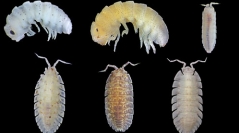

 European Journal of Taxonomy
793 (1) - Pages 1-50
European Journal of Taxonomy
793 (1) - Pages 1-50In this study, we report the results of a taxonomic survey of terrestrial isopods from Isla Grande, a ca 2 km2 island located in the north of Cartagena de Indias, Colombia. We found a total of 17 species belonging to nine families and 10 genera. Eight of these species have been reported only from the Caribbean region, nine are recorded for the first time in Colombia, and three are new to science and described here: Tylos negroi López-Orozco, Carpio-Díaz & Campos-Filho sp. nov., Stenoniscus nestori López-Orozco, Taiti & Campos-Filho sp. nov. and Armadilloniscus luisi Carpio-Díaz, Taiti & Campos-Filho sp. nov. Our revision also determined that the genus Microphiloscia is a junior synonym of Halophiloscia; and moreover, Halophiloscia trichoniscoides comb. nov. is redescribed. We also provide illustrations for Armadilloniscus caraibicus and Armadilloniscus ninae. Most (16) of the species were found in coastal habitats (i.e., beaches, coastal lagoons and mangroves), whereas the tropical dry forest harbored only two species. Molecular phylogenetic inferences supported the presence of three species of Tylos in Isla Grande (i.e., one new species and a new lineage within each of two known species). Our work on Tylos highlights the importance of combining taxonomic and molecular analyses to support taxonomic decisions and uncover cryptic diversity. Due to the multiple threats to Caribbean coastal habitats, taxonomic and molecular genetic research are urgently needed to understand biodiversity patterns of oniscideans in the Caribbean, which will inform strategies for their protection. Such studies will also contribute to our knowledge of their evolution, ecology, and potential uses, as well as the factors that have shaped the remarkable Caribbean biodiversity.